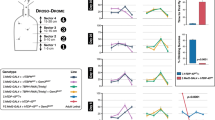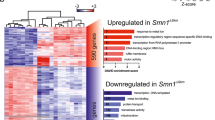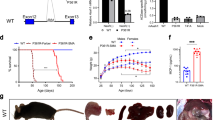Abstract
Classic spinal muscular atrophy (SMA) is caused by mutations in the telomeric copy of SMN1. Its product is involved in various cellular processes, including cytoplasmic assembly of spliceosomal small nuclear ribonucleoproteins, pre-mRNA processing and activation of transcription1,2,3,4,5,6,7,8. Spinal muscular atrophy with respiratory distress (SMARD) is clinically and genetically distinct from SMA9,10,11,12,13. Here we demonstrate that SMARD type 1 (SMARD1) results from mutations in the gene encoding immunoglobulin μ-binding protein 2 (IGHMBP2; on chromosome 11q13.2–q13.4). In six SMARD1 families, we detected three recessive missense mutations (exons 5, 11 and 12), two nonsense mutations (exons 2 and 5), one frameshift deletion (exon 5) and one splice donor-site mutation (intron 13). Mutations in mouse Ighmbp2 (ref. 14) have been shown to be responsible for spinal muscular atrophy in the neuromuscular degeneration (nmd) mouse15, whose phenotype resembles the SMARD1 phenotype. Like the SMN1 product, IGHMBP2 colocalizes with the RNA-processing machinery in both the cytoplasm and the nucleus16,17,18,19. Our results show that IGHMBP2 is the second gene found to be defective in spinal muscular atrophy, and indicate that IGHMBP2 and SMN share common functions important for motor neuron maintenance and integrity in mammals.
This is a preview of subscription content, access via your institution
Access options
Subscribe to this journal
Receive 12 print issues and online access
$209.00 per year
only $17.42 per issue
Buy this article
- Purchase on Springer Link
- Instant access to full article PDF
Prices may be subject to local taxes which are calculated during checkout



Similar content being viewed by others
References
Fischer, U., Liu, Q. & Dreyfuss, G. The SMN-SIP1 complex has an essential role in spliceosomal snRNP biogenesis. Cell 90, 1023–1029 (1997).
Lefebvre, S., Bürglen, L., Frézal, J., Munnich, A. & Melki, J. The role of the SMN gene in proximal spinal muscular atrophy. Hum. Mol. Genet. 7, 1531–1536 (1998).
Charroux, B. et al. Gemin3: a novel DEAD box protein that interacts with SMN, the spinal muscular atrophy gene product, and is a component of gems. J. Cell Biol. 147, 1181–1193 (1999).
Strasswimmer, J. et al. Identification of survival motor neuron as a transcriptional activator-binding protein. Hum. Mol. Genet. 8, 1219–1226 (1999).
Campbell, L. et al. Direct interaction of Smn with dp103, a putative RNA helicase: a role for Smn in transcription regulation? Hum. Mol. Genet. 9, 1093–1100 (2000).
Meister, G. et al. Characterization of a nuclear 20S complex containing the survival of motor neurons (SMN) protein and a specific subset of spliceosomal Sm proteins. Hum. Mol. Genet. 9, 1977–1986 (2000).
Jablonka, S. et al. Co-regulation of survival motor neuron (SMN) protein and its interactor SIP1 during development and in spinal muscular atrophy. Hum. Mol. Genet. 10, 497–505 (2001).
Pellizzoni, L., Charroux, B., Rappsilber, J., Mann, M. & Dreyfuss, G. A functional interaction between the survival motor neuron complex and RNA polymerase II. J. Cell Biol. 152, 75–85 (2001).
Mellins, R.B., Hays, A.P., Gold, A.P., Berdon, W.E. & Bowdler, J.D. Respiratory distress as the initial manifestation of Werdnig-Hoffmann disease. Pediatrics 53, 33–40 (1974).
Bertini, E. et al. Distal infantile spinal muscular atrophy associated with paralysis of the diaphragm: a variant of infantile spinal muscular atrophy. Am. J. Med. Genet. 33, 328–335 (1989).
Rudnik-Schöneborn, S., Forkert, R., Hahnen, E., Wirth, B. & Zerres, K. Clinical spectrum and diagnostic criteria of infantile spinal muscular atrophy: further delineation on the basis of SMN gene deletion findings. Neuropediatrics 27, 8–15 (1996).
Grohmann, K. et al. Diaphragmatic spinal muscular atrophy with respiratory distress is heterogeneous, and one form is linked to chromosome 11q13-q21. Am. J. Hum. Genet. 65, 1459–1462 (1999).
Zerres, K. & Davies, K.E. 59th ENMC International Workshop: Spinal Muscular Atrophies: recent progress and revised diagnostic criteria 17-19 April 1998, Soestduinen, The Netherlands. Neuromuscular Disord. 9, 272–278 (1999).
Cox, G.A., Mahaffey, C.L. & Frankel, W.N. Identification of the mouse neuromuscular degeneration gene and mapping of a second site suppressor allele. Neuron 21, 1327–1337 (1998).
Cook, S.A., Johnson, K.R., Bronson, R.T. & Davisson, M.T. Neuromuscular degeneration (nmd): a mutation on mouse chromosome 19 that causes motor neuron degeneration. Mamm. Genome 6, 187–191 (1995).
Chen, N.N., Kerr, D., Chang, C.-F., Honjo, T. & Khalili, K. Evidence for regulation of transcription and replication of the human neurotropic virus JCV genome by the human Sμbp-2 protein in glial cells. Gene 185, 55–62 (1997).
Molnar, G.M. et al. Association of the mammalian helicase MAH with the pre-mRNA splicing complex. Proc. Natl. Acad. Sci. USA 94, 7831–7836 (1997).
Zhang, Q., Wang, Y.-C.J. & Montalvo, E.A. Sμbp-2 represses the Epstein-Barr virus lytic switch promoter. Virology 255, 160–170 (1999).
Miao, M., Chan, S.-L., Fletcher, G.L. & Hew, C.L. The rat ortholog of the presumptive flounder antifreeze enhancer-binding protein is a helicase domain-containing protein. Eur. J. Biochem. 267, 7237–7245 (2000).
McEntagart, M. et al. Localization of the gene for distal hereditary motor neuronopathy VII (dHMN-VII) to chromosome 2q14. Am. J. Hum. Genet. 68, 1270–1276 (2001).
Wilmshurst, J.M. et al. Severe infantile axonal neuropathy with respiratory failure. Muscle Nerve 24, 760–768 (2001).
Fukita, Y. et al. The human Sμbp-2, a DNA-binding protein specific to the single-stranded guanine-rich sequence related to the immunoglobulin μ chain switch region. J. Biol. Chem. 268, 17463–17470 (1993).
Mohan, W.S. et al. Human S mu binding protein-2 binds to the drug response element and transactivates the human apoA-I promoter: role of gemfibrozil. J. Lipid Res. 39, 255–267 (1998).
Mizuta, T.-R., Fukita, Y., Miyoshi, T., Shimizu, A. & Honjo, T. Isolation of cDNA encoding a binding protein specific to 5′-phosphorylated single-stranded DNA with G-rich sequences. Nucleic Acids Res. 21, 1761–1766 (1993).
Grishin, N.V. The R3H motif: a domain that binds single-stranded nucleic acids. Trends Biochem. Sci. 23, 329–330 (1998).
Lorson, C.L. & Androphy, E.J. The domain encoded by exon 2 of the survival motor neuron protein mediates nucleic acid binding. Hum. Mol. Genet. 7, 1269–1275 (1998).
Grundhoff, A.T. et al. Characterization of DP103, a novel DEAD box protein that binds to the Epstein-Barr virus nuclear proteins EBNA2 and EBNA3C. J. Biol. Chem. 274, 19136–19144 (1999).
Acknowledgements
We thank the patients and their families for participation in the study. The help, discussions and critical comments on this manuscript of C. Bassir, M. Bollinger, S. Buttenberg, E. Eike, A. Huebner, A.Y. Manzur, J. Scholz, G. Stoltenburg-Didinger and A. Zwirner are acknowledged. This study has been supported by grants from the Deutsche Forschungsgemeinschaft (Hu 408/3-1, K.G. and C.H.; Ze 205/10-1, S.R.-S. and K.Z.; SFB 581, TPB1, M.S., Würzburg) and in part by the parents' support group 'Helft dem muskelkranken Kind', Hamburg, Germany (C.H.).
Author information
Authors and Affiliations
Corresponding author
Supplementary information
Rights and permissions
About this article
Cite this article
Grohmann, K., Schuelke, M., Diers, A. et al. Mutations in the gene encoding immunoglobulin μ-binding protein 2 cause spinal muscular atrophy with respiratory distress type 1. Nat Genet 29, 75–77 (2001). https://doi.org/10.1038/ng703
Received:
Accepted:
Published:
Issue Date:
DOI: https://doi.org/10.1038/ng703
This article is cited by
-
Cellular functions of eukaryotic RNA helicases and their links to human diseases
Nature Reviews Molecular Cell Biology (2023)
-
Clinical genetics of Charcot–Marie–Tooth disease
Journal of Human Genetics (2023)
-
Therapy development for spinal muscular atrophy: perspectives for muscular dystrophies and neurodegenerative disorders
Neurological Research and Practice (2022)
-
Current understanding of and emerging treatment options for spinal muscular atrophy with respiratory distress type 1 (SMARD1)
Cellular and Molecular Life Sciences (2020)
-
Model validity for preclinical studies in precision medicine: precisely how precise do we need to be?
Mammalian Genome (2019)



